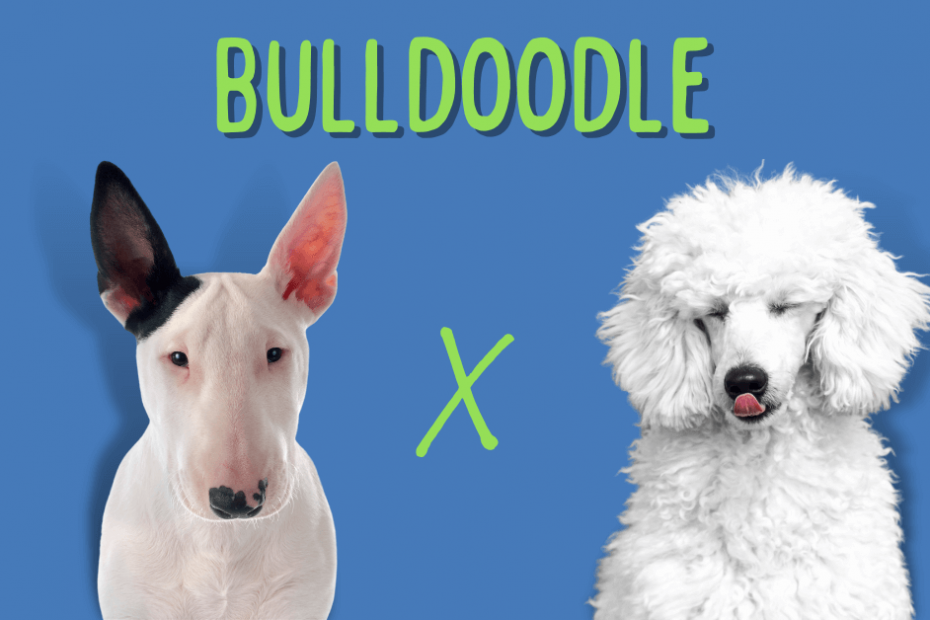Are you looking for a dog that is great with children? Or do you love Doodles but want a different kind of designer dog, something rarer and more exotic than a Goldendoodle?
Then consider bringing a Bull Terrier-Poodle Mix into your family, also known as the Bulldoodle.
Keep reading to learn more about this rare mixed breed!
What is a Bulldoodle?
The Bulldoodle is a mix between a Bull Terrier and a Poodle. It can be a mix of a Bull Terrier with a Standard Poodle or Mini Poodle. Or, it can be a cross between a Miniature Bull Terrier and a Standard, or Mini, Poodle.
The Bull Terrier-Poodle mix is considered a Doodle dog breed. The Bulldoodle is sometimes mistaken as a Staffypoo, which is an American Staffordshire Terrier crossed with a Poodle.
Get to Know the Bull Terrier

Bull Terriers make patient, dedicated canine companions. They are sweet-natured around children and devoted to adults.
Bull Terriers are sturdy dogs. James Hinks is credited as the breed’s founder.
The American Kennel Club quotes an old saying about the Bull Terrier’s founder: “Hinks found a Bull Terrier a battered old bum, and made him a dog for a gentleman’s chum.”
Like all descendants of the Bulldog, the Bull Terrier is full of muscle. They stand between 21 and 22 inches tall but may weigh up to 70 pounds.
Bull Terriers most commonly have black, white, or brindle coats. They also come in black brindle, red, fawn, tan, red smut, and fawn smut. Their coats may be one solid color or a combination of any other color found in the breed.
A murky past…
As a close cousin of the Pit Bull, Bull Terriers share the same animal-fighting ancestry. Their first origin traces back to the days of bullbaiting, which eventually led to dog fighting.
Fortunately, it only takes an hour or two to discover that a Bull Terrier likes nothing better than to please its human family. Other breeds occasionally leave you alone, but Bull Terriers want to follow you everywhere. Many Bull Terriers are athletic, but others are content to curl up in your lap.
Bull Terrier intelligence
Bull Terriers are averagely intelligent. They may need 25 to 40 training sessions to obey a new command. And they only obey commands without their owners having to repeat them about 50 percent of the time.

However, in the case of the Bull Terrier, a lack of super-intelligence may be a good thing. They don’t learn desirable behaviors quickly, but they don’t learn undesirable behaviors quickly, either.
Your training won’t be undone by someone else trying to teach them a different behavior. They aren’t as likely to figure out how to open a latched door, or the refrigerator, or how to escape from the yard.
Bull Terriers rank 61st on the AKC’s rankings of the most popular dogs.
Get to Know the Poodle

The Poodle is the national dog of France, but the breed originated in Germany. Their name comes from the German term Pudelin, meaning “to splash.”
Poodles were bred as water dogs, trained to retrieve ducks and other waterfowl shot by archers. They later became popular pets in the royal courts of France, beloved for their curly coats, pleasant dispositions, and high intelligence.
Poodles come in several sizes: Teacup or Tiny, Miniature, Standard, and “Giant.” Standard Poodles are often chosen to become the Poodle parent of Bulldoodles.
Poodles can have coats of white, black, black and white, gray, apricot, cream, sable, brown, silver, blue, or red. Bred to stay warm in cold water, they have curly hair that they don’t “shed.” Their hair comes out, but they fall inward instead of on the floor or furniture.
As a result, Poodles are nearly hypoallergenic. They don’t leave dog dander around the house, although they need regular brushing to keep fallen hairs from accumulating in their coats.
Canine intelligence expert Stanley Coren ranks Poodles #2 on his list of dog breed IQs. They obey commands over 95 percent of the time. It only takes about five repetitions for them to learn a new command.
Poodles are easy to train. They have a sense of humor. They can constantly delight their owners. Nobody will be surprised to learn that they consistently rank in the top 5 of America’s 197 most popular breeds.
What Do You Get When You Have a Bulldoodle?
When reputable breeders pair Standard Poodles with Bull Terriers, the result is a unique Doodle with the intelligence, nearly-hypoallergenic coat, playfulness of the Poodle parent, and the muscularity, athleticism, and intense loyalty of the Bull Terrier parent.
Size
Bulldoodles combine the sturdy muscularity of their Bull Terrier parent with the sleek athleticism of their Poodle parent. They will (if the Poodle parent was a Standard Poodle) stand at least 14 inches tall.
Adult females will weigh 24 to 50 pounds, while males can weigh 28 to 60 pounds.
Coat
Bulldoodles can have coats of beige, black, blue, apricot, brown, cream, café au lait, fawn, red, silver, white, or brindle.
The genetics of hair texture works out so that about 3/4 of Bulldoodles have long, wavy hair, while about 1/4 will have long, straight hair. The curlier the hair, the less the shedding and the lower the allergenicity.
Bulldoodles need brushing two or three times a week and anytime they have been outside in high grass to remove ticks. Longer-haired Bulldoodles will require careful attention to flea control.
Traits & Characteristics

Temperament
Temperamentally, you can expect your Bulldoodle to be a cuddle bug. Bulldoodles love to be around their family.
Bulldoodles are great with children. They are patient and sweet-natured.
Like other intelligent dogs, Bulldoodles adapt to change well. They don’t get upset with a change in routine. They don’t experience separation anxiety when the kids have to stay after school, or you come home from work a little late.
How well your Bulldoodle relates to other dogs and cats depends on the training they receive as a puppy, between the ages of about seven weeks up to about six months.
Bulldoodles that have positive experiences with other dogs and cats during this stage of their development will relate to other animals more easily for the rest of their lives. But it is rare for a Bulldoodle to be aggressive toward other animals.
Bulldoodles don’t bark a lot. They love to play but are happiest when they have a job. Teach your Bulldoodle to pick up his toys. Train your Bulldoodle to close doors, fetch your slippers, or place trash in the trash can.
Give your Bulldoodle puzzle toys, a flirt pole (a pole with a long cord with a toy attached to its end), or a Kong toy (a bobble toy that dispenses a treat when your dog knocks it down). Bulldoodles can learn how to play hide and seek and chase dog-safe bubbles.
Can You Give a Bulldoodle a Good Home?
Bulldoodles are highly adaptable dogs. They can lead happy lives with families in houses with yards, townhouses, and even apartments. The main requirements for a happy, healthy Bulldoodle are:
- Minimal time going up and down stairs. Bulldoodles can inherit genes for hip dysplasia from their Poodle parent, even though the breeder will do testing and try to avoid this situation. Going up and down stairs as puppies can activate the problem.
- Wet as well as dry dog food. Bulldoodles inherit a natural tendency to deficiencies in folate, B12 , and iron from their ancestry. They have deficient “intrinsic factor” production, which helps them absorb it. Any dog food that includes liver (usually chicken liver) will relieve this problem.
- Regular tooth brushing. Bulldoodles inherit a very high risk of gum disease and tooth decay from their Poodle parent. They must have their teeth brushed with a flat toothbrush designed for dogs and additive-free, liver-flavored canine toothpaste several times a week.
Due to hybrid vigor, Bulldoodles don’t get many health problems that can plague their parents.
Lifespan
Given good food, daily playtime, and lots of love and attention, your Bulldoodle may be part of your family for as long as 15 to 18 years.


